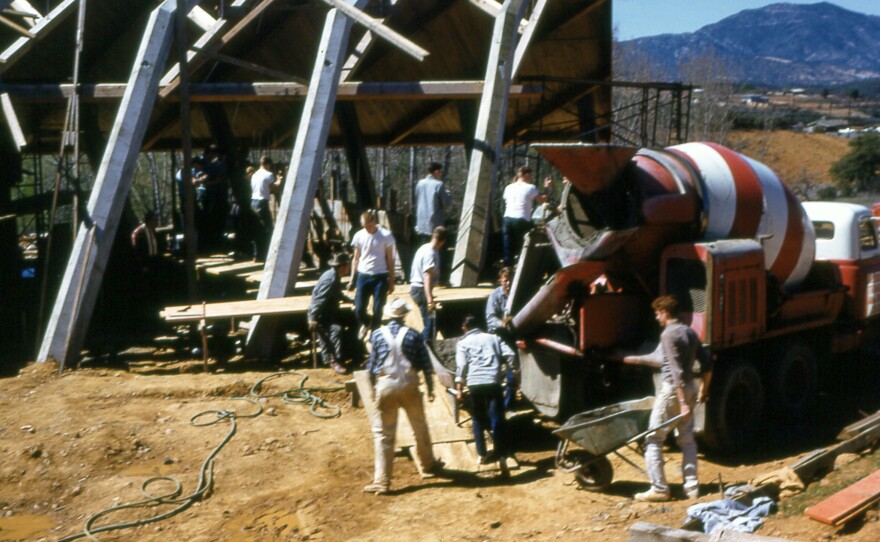Architect Frank Lloyd Wright designed over a thousand buildings during his long career. Only ten were houses of worship, and one of them was the Pilgrim Congregational Church in Redding. A team of Shasta County historians has produced a film documenting how the church convinced the man who was designing the Guggenheim Museum to take on their commission.
But the film is less about the famous architect, and more about "the little congregation that could,"which ended up using its own members to build a Frank Lloyd Wright landmark.
Back in 1957, Redding California was a small town with only 12,000 residents, and the Pilgrim Congregational Church was just getting off the ground, meeting in rented halls, and forming a committee to build their own house of worship. Minister Ray Welles was 27. It was his first job shepherding a flock. He was there when the committee began talking about all the elements they wanted in their church. He says someone joked ...
Ray Welles: “'We’re so hard to satisfy, you’d think we’d need a Frank Lloyd Wright!' And the chairman said, 'I wonder what’d happen if we phoned him.' And being an architect, he knew where he was and how to get in touch, so he phoned him! And it was some weeks later that the message came back, 'Tell the little church I’ll help them out.'”
And that’s how the Pilgrim Congregational Church became the last sacred space designed by Frank Lloyd Wright. He called it “Pole & Boulder Gothic.”
Wright never got to see it. He passed away in 1959, shortly before ground was broken. But like many of his designs, it’s become a landmark in Shasta County.
Last Fall, Sue Lang, a board member of the Shasta Historical Society spearheaded a project to film The Wright Time, documenting the building of the church.
Sue Lang: "My goal was to have a recorded history; an oral history of the people who worked hand in hand with Frank Lloyd Wright. That’s a significant event that happened in Redding, and I felt it would be so good to have this on film for future generations to hear this story. When we sat down for the first time to begin the taping, and I said, 'Let’s just do the interviews and let’s see what happens.' And as a result of that this great story unfolded."
There were a number of tales to be told in The Wright Time that weren’t common knowledge. One unexpected treat for the team was digging up some rare home movie footage of the construction that’s now included in the film.
But perhaps the most surprising story that came out during the interviews was that with such a limited budget, the congregation couldn’t afford to have a general contractor do all the work. So the parishioners, along with volunteers from the community, picked up hammers and paintbrushes, even borrowed heavy machinery from the nearby Whiskeytown Dam project, and built much of Frank Lloyd Wright’s design themselves.
Marge Bland: “I worked with the other women making telephone calls for work parties to come and making calls to people in the church to bring sandwiches. And we had the job of painting the asphalt on the rock walls all around the building which would later be covered with concrete. And we had buckets and we had tar and we had dish mops.”
And it wasn’t just the adults.
Sue Lang: "I was initially just going to go after the adults at the time, not even realizing how much a part the children played in this church. Then we started talking to people who are now adults, but they were kids at the time. And those were great interviews because there’s this wonderful memory that they talk about that time with such reverence and such pride, and I thought 'What a great gift to give to a child.' To know that they were such a part of a big project, and their work was valued.”
Brothers Andy and Steve Main are now in their late 50’s and early 60’, but when church construction began, they were still young boys:
Andy Main: "I remember dad taking us out on weekends in the station wagon and gathering the rocks. Yeah, there was more than one trip. We went out past Whiskeytown and got loads of rocks. The old green station wagon?"
Steve: "We had an old green station wagon. And dad would load us up. But we would grab these boulders and lift them into the back of the station wagon and carry two or three or five of these big boulders back to the church. That was one of the most memorable parts for us, going out into the woods, having a day adventure."
Although Frank Lloyd Wright never visited the site himself, one of his apprentices at Taliesen West did come to Redding to oversee the project, Anthony Puttnam. Puttnam says he lived on the site in a small travel trailer until it got too cold, and one of the families from the congregation took him in.
Puttnam believes that the hands on participation by the men, women & children brought a deeper connection to the space that still stays in his mind 50 years later:
Tony Puttnam: "After the building was finished, the people who worked on the church, brought their families to see the building in the daylight. And things like that, you know, I can still tear up about. Somehow we had succeeded in giving them ownership. And that is something that was priceless.”
The Shasta Historical Society premieres The Wright Time Sunday, March 16 afternoon at Redding’s Cascade Theatre at a 2pm screening. Its free, open to the public and followed by a Q&A with the participants and filmmakers.







